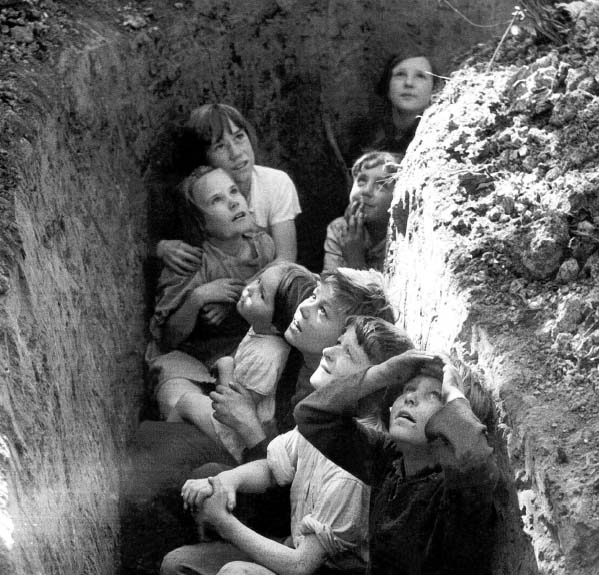Visual image and discussion exemplar: questioning a photograph
Exemplar

Almost more than any other source a photograph provides an incentive to dig, to burrow, to stretch, to tease out, to investigate and follow up leads.
A good starter activity. We used a photo in this way to begin our Britain since 1930 unit with a mixed Year 5/6 class. We chose a picture of children looking out of a trench to stimulate the children's thinking, questioning and discussion. We mounted it in the middle of an A4 sheet, leaving lovely wide borders, and made 16 photocopies.
The photo shows children of hop-pickers watching the Battle of Britain raging overhead, Kent, 1940.
Download a high quality version of the photograph for photocopying (attached below).
The teaching:
Looking at a photo
We handed out copies of the photo, one per pair of children. We told them to look at the picture and decide what it was about overall, then to focus on details within it. After this close examination, we asked the children to write on the sheet any statements which they could make for certain, and any questions they wanted to ask about the photo.
Children's questions
After 10 minutes, we gathered the class around the board and recorded their questions. They rained thick and fast, serving to focus the discussion:
English or Germans?
In or out of a shelter?
Why trenches?
Why squashed?
When did they see what they're looking at?
Is it a play?
Where are they?
What was it like?
Could they be grown-ups now?
Why looking up?
Hot or cold?
Why looking in different places?
What year?
Can you tell if they're happy?
Why no adults?
Smiling?
What ages are they?
How would they get the picture?
What are they sitting on?
Who took it?
Abandoned by parents?
Christians or Jews?
Why would the picture be taken if there was danger?
Discussion
The questions stimulated a vigorous discussion, with children suggesting answers (e.g. 'They could be looking at aeroplanes').
We moved on to explore the role of the photographer who took the picture, and reasons why the photograph should take that form. Why was the picture taken and published? We told the children about censorship and Government control of the press during the war.
From this arose hypotheses that the Government published the picture because it wanted people to join the forces, to get them to protect British children, or to warn people to get their children into safety. The final part of the discussion led on to the idea of the photograph being propaganda. One pupil even suggested: 'Is it a fake?'
Reflection
This was a driving piece of teaching and learning, in which the whole class was fully engaged, paying attention and involved. The open-ended challenge of the activity motivated the children and the discussion stimulated their thinking.
From Teaching Primary History pages 141-2. Heinemann, out of print.
Attached files:
- Children in Trench
1.68 MB PDF document

